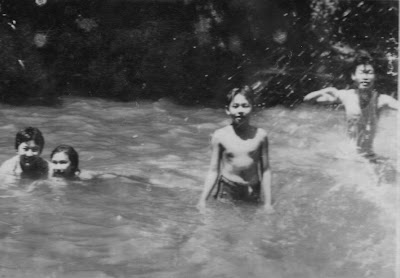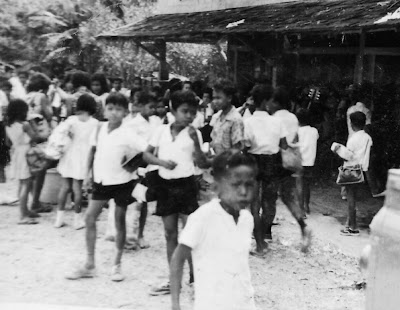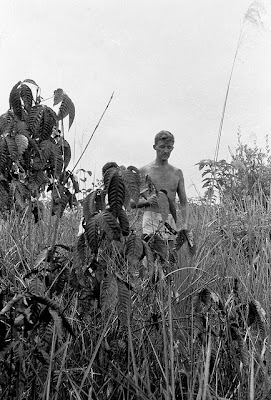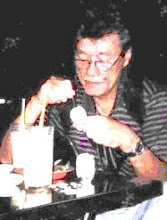St.Thomas' School,Kuching
The release of SC examination result, March 1965, prevented me from going for my further studies. So I’d have to get a job, then. In those days, getting a job was easy and in fact, we didn’t have to look for a job but instead, lots of jobs looked for us. During the last 2 months of our time in school, our school principal, Father Wellington, used to come to our class and, with a piece of paper in his hand, asked: “Who wants to work as a … and how much you’d get…interested come to my office…” One day, he came again and said, “…who wants to be trained as a teacher? …being a teacher won’t make you a millionaire but you’ll have long holidays when you can do what you want… ”
In May,1965, the officer in the office of Batang Lupar District Council showed me a list of schools, more than 10 of them, with vacancies where I could choose to teach. I decided to take SRK Melugu because it is near to Simanggang Town
今早在七哩图书馆翻阅一本叫 «My Sarawak Celebrating 45 Years Of Progress, 1963-2008»发现一张我的照片。那是1 9 6 6年我在离成邦江1 0哩外SRK Melugu当二年多临教的生活照。我还记得那是Mrs. Tom H. Harisson来校替我们照的。她的丈夫是当时砂拉越博物院院长。这一班是六年级会考班,几乎全部的科目都是由班级任负责教的。嘿!嘿!穿着短裤上课,没事!
担任临教的手续办妥后,沈绍藩挚友带我去姆鲁古一趟,首先去见一位住在姆鲁古的华裔长者莫必(Mupit) 。闲谈中,听到我是姓林的,莫老说:“在印尼宋宫(Sungkong) 这个地方的土族,全都姓林!” 莫老是印尼人,曾经在宋宫一带做小生意,最后才步行越过边界来到姆鲁古定居。过后,莫老带我们去拜会我的校长Mr.Belfour Dundang.
图:Rumah Panjai Melugu,1965
My Days In The Forest of Sungei Dor
1965 – 1967
Sungei Dor flows from Sarawak/Kalimantan Barat border and meets Sungei Klauh beyond Melugu longhouse and then into Sungei Munggu Isu. From here it goes onto Batang Lupar near Banting, Lingga.
Longhouses along Sungei Dor include Po-ai, Batu Besai, Tekalong and Melugu at the lower part.
SRK Melugu at that time had a population of 200 pupils(6 classes) and 9 teaching staff, of which, 50 of them were boarders and they were from Po-ai and Batu Besai.Tekalong is only 45-minute walk from Melugu.
Indeed I was going to an interesting life in this part of Iban world.
Picture: SRK Melugu school photo, 1966
My headmaster, Mr. Belfour Dundang, from his house, pointed to a broken little house about 20 meters away and said:
“That’s your quarters and you’re going to share with David Kalom and his cousin, Vincent.”
David, from Bangat, Betong was a temporary teacher like me and his cousin followed him to study here at Melugu. Before long, my cousin, Ah Tee, joined us and all in all, 4 of us lived here.
In those days, especially in rural areas, school children in-take was simple. There was no age limit, not necessarily to seek approval from the education authority and as long as the headmaster allowed, anybody could come and joined any classes they wished to. My cousin finished his year 6 courses at Chong Hua School
Picture: The broken little house where I lived
Our precious dog, Blackie, died suddenly and we buried him in front of our hut. David suggested that we should have a sort of funereal ceremony and we did, by erecting a cross and putting candles on the grave. Almost all boarders assembled to observe the occasion and many of them sobbed because they were going to miss their loving little playmate, Blackie, forever and ever.
Picture: Boarding House, SRK Melugu,1965
As mentioned earlier, SRK Melugu was a boarding school. About 50 boarders stayed in an old wooden house just next to our quarters. The local district council employed a school-mother (indai-skula) to cook for them and of course, to sleep with them, too. Boarders brought their own rice at their own will but when they had consumed their own rice, they would have to take rice of very low-quality supplied by the US
All boarders must go home after school on Friday,except few of them who came from Skrang, and they would be back on Sunday afternoon.
Ho! Ho! Sunday evening meal was always great for me. All kids would bring all sorts of food from home.
“Master! Nuan deka makai jani utang? ”
“Ular sawa?”
“Burong punai?”
“Isi kera?”
“Ka! Ka! Ka!” meaning “Yes! Yes! Yes!” was always my answer.
From here, I tasted wild-bore, snakes, lizards, monkeys, worms, birds, insects, wild-cats, and many other jungle-animals and in short, “You mentioned, I’d tasted!” Ha! Ha! Ha!
In those days, school-displine was not a problem at all. All pupils were obedient and honest. Hence, class-control was easy to handle. Co-operation between teachers and parents were excellent. Parents never came to school and made any complain on teachers. Everybody was happy either in class or after class. One day, something interesting happened:
All of a sudden, everybody in my class ran away from the classroom and at the same time, I saw students from the other classes did likewise. Many pointed to a certain direction and shouted:
“Ding! Ding! Ding!..” (there!)
Only then I knew that there was an airplane up in the sky.
My headmaster smiled at me and I smiled, too.
When they were back in class again, each and everyone would talk on the subject for quite sometime.
From then on, I was excited to go out with them…
My Days in the Forest of Sungei Dor
Physical Education in military training style
My headmaster, Mr. Belfour Dundang, was talented at wood-carving. He taught our students how to make wooden guitars. My class managed to form a musical instrument team.
Gawai Dayak was first celebrated on 1/6/1965 in place of Sarawak Day. At Melugu, first Gawai Dayak was not celebrated merrily as it is today. As I could remember, my headmaster brought us to visit the 70-door longhouse during that Gawai Dayak eve. We went from door to door and were served with tuak and penganan. No miring, no ngelulun pulut, no music and dances and everything was quiet.
“How do your people celebrate Chinese New Year?” Mr. Dundang asked me sometime in early 1966.
“We have fire-crackers, lion-dances…”
“Can you do it?”
“I’ll try.”
Without further ado, I started plastering and pasting a frog-lion-head and started training my boys by using some local musical instruments like kompang, gendang and gong. In addition, I borrowed few sets of Chinese musical instruments from Soon Heng Association, Simanggang.
So, in the eve of Gawai Dayak, 1966 , there was a team of lion-dancers merrying around in the longhouse…
The school padang just down the longhouse flooded if heavy rain poured for hours and especially so during landas season. Children played on the water until late in the evening.
Many a time my boys and I walked at least half an hour up river and from there, each of us would find a batang of floating wood and we’d claspe in the arms or sit on it, off we went following the fast running water down stream. Singing, screaming, shouting all the way as if we were going for ngayau(attacking the enemies). In front of us, we often saw big snakes, big lizards and other animals crossing the river. The excitement came to an end when we reached the bridge at the main road and we walked back to the longhouse again. Who was I? I really didn’t know…
It was indeed interesting to take pictures while young ladies washing and taking their early bath at lubok sungei Dor. Bebuti with indu dara was real fun!
Sometime, during weekends, my students and I liked to go to the temawai(fruit garden) and stayed there for the whole day looking for fruit to eat. From there, I learned many more types of local fruit. It was more fans if some indu dara came along with us. We played seek-and-hide in the bushes, chasing each other up on the tree or even jumping from one tree to another…
A Trip to Wong Pupu, Batu Lintang, Undup
August school holiday, 1966, we hired 2 big buses (each RM60.00) from STC(Sarawak Transport Company) to take us(almost 100 in number) from Melugu to Batu Lintang for a day educational tour. We cooked and had our lunch at Wong Pupu. On our way back, we stopped at Temudok agriculture station where many were given fruit plants…
Photo taken in front of Batu Lingtang bazaar
Crossing over the hanging bridge near Wong Pupu
Temudok Agricultural Station, Simanggang
My First Trip to Po-ai
Mr. Dundang, my headmaster, told me that there’d be a ‘belah pinang’ at Po-ai the following week-end and asked if I liked to come along.
That was a Friday afternoon at 4 and we all set to go, not less than 30 of us. Two young men, each carried a huge slaughtered pig on his back. We walked with extensive steps for almost 2 hours and I began to feel tired as I’d never walked such a long distance before. I asked how long should we have to walk and an elder answered,“enda jauh agi,kira sebatang roko!”(not far enough, about a stick of cigarette). Haha! A normal ‘sebatang roko’ means we’d have to walk for at least another half an hour. It was 6 now and I was hungry. I thought that we might have our dinner at 9 the earliest if we were going to have the pork we brought with us for it took time to cook all these stuff. At dusk, we reached Po-ai for good. Immediately the dead-pigs we brought were cut into pieces and each door share a piece and by 7.30, every door came out with a full bowl of pork, in different courses, at the ‘ruai’ of Tuai Rumah Tugun! Makai kitai…Ha ha ha…that was a communist way of life, no doubt!
Picture: Po-ai in the sixties.
Balwin, Vincent, Morgan, Mr. Lim
The next day, Saturday, was the routine day of the week, to “ngabas peti” which the longhouse people installed at the top part of the mountain near the Malaysian/Indonesian border the week before. This type of “poison dart trap” was to dart wild big animals like wild bores and the like and if targeted, the animal would die at a short distance from the trap.
We went up the mountain very early in the morning. I was asked to follow one of the leaders very closely fearing that I would wonder elsewhere and attack by the dart myelf.
“Oh ha……!” we heard someone cried. And my leader told me that I brought them big luck for they caught something. We continued fetching until all the traps we supposed to go over come to an end. Of course, we re-installed them again on our way back.When we came back to our starting point, I saw a very big dead wild bore lying on the ground.
Everyone was excited and was even more excited when they learned that the unlucky animal was caught not very long ago because it was still fresh.
Someone cut the dead into pieces and everyone present lent a hand and took a piece of the meat to the longhouse which was about half an hour journey away. Hooray! We were going to have another big party tonight!
We went up the mountain very early in the morning. I was asked to follow one of the leaders very closely fearing that I would wonder elsewhere and attack by the dart myelf.
“Oh ha……!” we heard someone cried. And my leader told me that I brought them big luck for they caught something. We continued fetching until all the traps we supposed to go over come to an end. Of course, we re-installed them again on our way back.When we came back to our starting point, I saw a very big dead wild bore lying on the ground.
Everyone was excited and was even more excited when they learned that the unlucky animal was caught not very long ago because it was still fresh.
Someone cut the dead into pieces and everyone present lent a hand and took a piece of the meat to the longhouse which was about half an hour journey away. Hooray! We were going to have another big party tonight!
It was not often for a longhouse people to give away the teeth of any animal they caught to someone else. Since, as what they said, I brought them luck, the pair of wild bore teeth were given to me and I still keep them, until the day I die…
Po-ai, during that time, consists of 40 doors or more. The longhouse was well built and very need and tidy, I should say. In those days, if these was any function or gathering going on at Po-ai, I should be there, too. With a gun in my hand, I liked to wander in the jungles…
Picture shows Po-ai from the top of the hill.
A Trip to the Sarawak/Kalimantan Barat Border
Po-ai is very near to the Malaysian/Indonesian border and from
here; you can cross the border within a few hours’ walk. One day in 1966, about
30 of us(teachers, pupils and longhouse folks) we packed and off we went into
the deep jungles. Our leader was Councilor Gimang and assisted by a few other
young men from Po-ai.
Councilor Gimang told us that we’d walk for the whole day
long and on our way we might encounter:
- The so-call communist-terrorists, members of PARAKU(Pasukan Rakyat Kalimantan Utara) who had been roaming about along the border since the Confrontasi but we didn’t have to worry much because they were friendly to the longhouse people.
- Indonesian Dayak (Bugau) who might have their hunting business around on the land where it was difficult to distinguish whether it was Malaysian’s or Indonesian’s. To show our friendliness, we prepared boxes of cigarettes (Rough Rider), sticks of soap, boxes of matches(Ant brand) and salt as gifts.
Picture shows Councilor Gimang and our GB, Belfour Dundang
having their lunch break

After walking for 6 hours, we reached the first river we met
on our way. The river was about 6 meters wide and 1 or 2 meters deep. The water
was running slowly. We were now in Indonesian land because the water flew into upper
Kapuas, according to our Councilor. Our leaders decided that we should have a
rest and had our lunch here. Without further ado, many of us jumped into the
river and had a foreign river swim.
“Master, the river is the same like ours!” One of my
students exclaimed.
Not long, I saw many, with the help of someone, checking head,
shoulder, knee and toe of his/her own. I knew that they were trying to find out
if they were leech-beaten. Ho ho I found a leech attached to my toe, still
sucking my precious blood though…
In this picture, I still can see, Dimos, Brandah, Lewis, and
Boon Siaw…
At about 1 pm, we started moving again. From here, we were no more in the jungles as what we could see, the land around us was ...flat, grass-lands and from the look of it, it had been cultivated by the Indonesian Dayaks, no doubt. And if it were the case, we might be lucky enough to meet them in persons or get into their village. We looked for it, anyway.
Not long, we came across another river which was wider and deeper and the water was crystal clear. Without any favorable instruction from our leaders, many of our boys jumped into river and started screaming around. Temptations invited me to be in the very cool water,too. Wo wo…I felt both of my legs beaten and at the same time, I heard some boys shouted:
“ Master, aku kena gigit ikan! Amat pedih !”
“Oh jaga amai amai anang meh UTAI nuan nyau lagi!(beware of your THING!)” Someone raised up his voice from the bank of the river.
At once, everyone came out from the water.
It was a nice place for fishing,I think…
Councilor Gimang told us that before sunset we must find a
place to rest for the night. He was not certain if we could reach another river
where, he still remembered, we could find a cave nearby to prepare our dinner
and to spend the night. It was almost 3 pm now. The sun was hot and we walked
directly under it—no trees to shelter us from the heat. We walked faster than
usual and as for me, I felt like running to my death. All of them seemed to be
ok except that I heard no joke anymore!
“Batu dinding! Batu Dinding!”someone shouted and pointed to
a far distant-land.
Alas! That was a mass of wonderful sharp jagged and very
high peaks!
Unfortunately, we couldn’t go over there because they were
still hours away from our site.
Interesting enough, as we were told later on, there were many
Dayak stories to follow, including
Keling and Kumang who lived there once upon a time! Believe it or not, Keling
left behind his stone foot-print there!
I really liked to take the challenge to conquer its steep
slopes one day! But this “one day” will never come!
Looking at my old watch again, it was 5 pm. My drinking water
which I collected from the stream somewhere as we walked along had already been
consumed. Everyone was tired, really tired.
Half an hour later, we finally reached another river. The
river was big but shallow, with stones of various size and shape in it. Our
leaders reminded us that we had only 30 minutes to enjoy in the river and after
that, all of us would have to start to work, to prepare our dinner and to find
a place to sleep for the night. We might just sleep beside the river, even it
was going to rain.
We were lucky because soon we found a big cave just meters
away from the river. We were only allowed to stay outside the cave while some
elders got into it and they came out later on telling us that there was a vast ‘bilik’
just right in front of us. We could sleep there quite comfortably for the night…”Ho
ho! I’d be the king for tonight but will I have a queen for tomorrow!”
Some boys shared to fetch fire-wood while the girls prepared
to cook. Everybody gave up the little ‘kong’ of rice brought from home. The
three gun-men went a little further to shoot anything they met. Few of us
prepared simple hooks with worms to catch fish in the water of the cave. Ikan “Keli”
were plenty. Within 30 minutes, I caught at least 3 kg of keli.
Before the dark fall, we had our dinner and we still had
some remains for our breakfast the next day. I enjoyed the sweet keli a lot…
After the dinner, our leaders asked each and every one of us
to find a place to rest and sleep. I was in the middle of my boys.
Before long, our pillow-talk began. Some boys suggested that
if we established a new kampong since natural food was plenty here. I said that
I’d choose 20 boys and 20 girls to live and create families here and I’d be the
‘king’.
“Who will be the queen?” someone asked.
“Indai Sekula!”the other replied.
Ha ha ha…
Chatting in the dark cave ended in no time as all were very
tired after a Day’s long walk. Our leaders spent some time discussing if we
should continue our journey or return home the next day. Oh how I wished if we
could go on…
We slept head to head and in the middle of the night, I felt
someone caressing my hair. That night, I dreamed that Cliff Richard was
singing:
“ …how beautiful to
feel my arms around you
Kissing your eyes
Hearing your sighs
Touching your hair….”
Next early morning, after simple breakfast, we moved further
south.
According to Councilor, these areas should be occupied with
either farmers or hunters from the other side but so far, we found nobody
around.
At a cross-trail, we decided to turn back, using another way
which was nearer, about 6 hour-walks to Po-ai.
We walked and walked and for how long, I didn’t realize when
we saw a ‘langkau’ just by the side of the trail. We had our food here.
The occupant, Remong, from Klauh, with his family had been
here for a week hunting and fishing and of course, looking for other
jungle-products. Asked when they would be back: a month, perhaps, the longest
stay.
Remong said that it would take us 5 hours to reach Po-ai and
we would be there at 8 pm because it was now 3 pm.
Good-bye to this young lady!
My Days in the Forest
of Sungei Dor, Dau,Simanggang
1965 – 1967
1965 – 1967
Ruma panjai Batu Besai in the 60s
Apai Kumang
Apai Kumang or rather Mr. Arthur Thwaites was a member of
the Peace Corps from the US. How did he get the name Apai Kumang? I didn’t
know. He was single and as far as I know, he did not adapt any child or
whatever.
He arrived in Melugu
in October, 1965. He was assigned as one of the assistants to the Manager (the
late Mr. Ali Majang) of Melugu Development Scheme for a year or so. He was then
moved out of Melugu and worked somewhere else.
I met Apai Kumang for
the first time at the Development Scheme office in January,1966.
I was surprised to see him wearing shorts but without shirts
and he was bare-footed, too. He stayed
alone in a small 3 meters square langkau (hut made of leaves) at the top of a
hill just opposite the Melugu Secondary School.
From then on, I saw him almost everyday: walking around all over
the places, meeting or gathering in the long house. He used my class, 2 or 3
times a week, to teach about 20 local men
and women some general knowledge of current affairs and the hot topic then was
the Indonesian confrontation issue. He could speak Iban very well. After all, Apai Kumang was really a nice chap……
Mr. Frary & Miss Sadowski
Besides Apai Kumang, there were, at the same time, more
members of the US Peace Corps serving in Simanggang. I knew two of them:Mr. Bob
Frary and Miss Ruth Sadowski . They were teachers and they both introduced and
incharged of the newly teaching method called PEMS---Primary English Medium
Scheme. Mr. Frary travelled from school to school in Simanggang to supervise
the new scheme whereas Miss Sadowski taught in Melugu Primary Council School.
We could see teachers from other schools to attend Miss Sadowski’s class. She demonstrated
first of all and later on the teacher was asked to teach. During that time, our
headmaster, the late Mr. Belfour Dundang, was indeed a very busy man.
Soon enough, Mr. Frary married a beautiful local lad from
Po-ai and I was told the wife followed Mr. Frary to US…






























































No comments:
Post a Comment